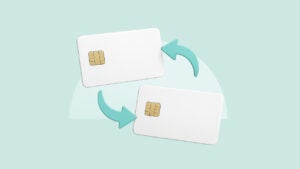What to do if your identity is stolen: 10 steps to take

If your driver’s license number, Social Security number or other personally identifying information is stolen, knowing what action to take and acting as soon as possible is important.
Most identity theft occurs through cyberattacks, such as phishing emails, smishing text messages and malware, according to the nonprofit Identity Theft Resource Center.
If you discover the breach early and act without delay, you could minimize the damage to your finances and/or your reputation. Here are steps to take if your identity is stolen:
- Notify the company or agency that issued your stolen credentials.
- Put a freeze or fraud alert on your credit.
- Report the theft to the Federal Trade Commission.
- File a report with your local law enforcement agency.
- Obtain copies of documents used to open accounts or make fraudulent transactions.
- Get copies of your credit reports and correct errors.
- Change passwords.
- Contact other companies or entities where your stolen credentials might be used.
- If you have identity theft insurance, file a claim.
- Sign up for credit monitoring.
1. Notify the company or agency that issued your stolen credentials
“Report your stolen ID immediately to the agency it was issued from,” says John Buzzard, lead analyst in fraud and security at Javelin Strategy & Research.
If your bank account was breached, contact your bank. If your credit card number was stolen, notify the institution that issued the credit card. Contact the Social Security Administration if your Social Security number has been compromised.
“Don’t delay this process,” Buzzard says. “If a criminal commits a crime using your identification, the authorities may pay you a visit, especially if the ID was physically abandoned or recorded during the commission of the crime.”
2. Put a freeze or fraud alert on your credit
Contact each of the major credit reporting bureaus – Equifax, Experian and TransUnion – and ask for a freeze or fraud alert on your credit file. These powerful tools are free and will not affect your credit score.
A credit freeze blocks third parties from accessing your credit. So, if you apply for a mortgage and there is a freeze on your credit file, the lender cannot check your credit unless you lift the freeze.
There are exceptions, however. Employers and landlords doing background checks, a collection agency working for a company to which you owe money and federal, state and local government agencies might still be able to access your credit. Read the details of the freeze for each reporting bureau.
A credit freeze would also not prohibit a credit monitoring service you have chosen from checking your credit.
A fraud alert initially lasts for one year and requires potential lenders to contact you to verify your identity before extending you credit.
3. Report the theft to the Federal Trade Commission
The FTC’s IdentityTheft.gov takes you step by step through the identity theft reporting process. Reports are tailored to specific credential breaches, whether it’s a stolen Social Security number or other personally identifying information.
The FTC does not investigate identity theft. Rather, it supports and facilitates the investigation and prosecution of ID theft by being a clearinghouse for ID theft reports.
Make a copy of your report. Banks, creditors and other entities will probably ask for it.
4. File a report with your local law enforcement agency
It’s a good idea to report the breach to your local police in case an identity thief presents your credentials during a traffic stop or arrest. Also, report to banks and other companies where they might ask for your identity.
Take a valid driver’s license or other proof of your identity with you when making the report.
5. Obtain copies of documents used to open accounts or make fraudulent transactions
Get copies of all documentation that was used to fraudulently open accounts in your name, make purchases or transact other illegal business. Make the request in writing.
If the identity theft pertains to the IRS and your taxes, fill out this form to request a copy of the fraudulent tax return.
6. Get copies of your credit reports and correct errors
Ask each of the major credit bureaus for a free copy of your credit report. Carefully read each report, checking for unauthorized accounts and errors.
Write the bureaus and ask them to correct errors, explaining what happened. Provide documents to support your request and keep copies of everything. Send your letters and paperwork by certified mail, with a “return receipt” so you have proof the bureaus got your requests. They have 30 days to investigate after receiving your request.
7. Change passwords
It’s never a good idea to use the same password for a very long time. Many businesses mandate password changes for their employees at regular intervals.
Create complex passwords for accounts, using at least 12 characters. Consider using a password manager, which is a good tool for creating, storing and safeguarding passwords. Multifactor authentication, which inserts another step like fingerprint verification into the verification process, adds more protection.
Some logins can’t be changed. It might have to be your first initial and last name, for example. But if you can change logins after identity theft, do so.
8. Contact other companies or entities where your stolen credentials might be used
You don’t know where identity thieves will use your stolen credentials, so try to get ahead of them by alerting places where they could strike. “A thief will try to monetize your data in as many ways as they can,” says Eva Velasquez, president and CEO of the nonprofit Identity Theft Resource Center.
Even if it wasn’t your Social Security number or Taxpayer Identification Number that was stolen, let the IRS know you’re a victim of identity theft, just in case. Fill out IRS Form 14039, an identity theft affidavit, and check the box in Section B that says: I don’t know if someone used my information to fraudulently file taxes, but I’m a victim of identity theft.
Notify your state Department of Motor Vehicles, health insurance company, mortgage company and other places where your stolen identity could benefit a thief.
9. If you have identity theft insurance, file a claim
If you have an identity theft insurance plan, file a claim. Some ID theft protection services are good about helping victims complete paperwork, make calls and take other steps to restore their identities.
10. Sign up for a credit-monitoring service
Credit monitoring is a service that checks your credit files for suspicious activity and notifies you. CreditWise from Capital One is free. Experian also has a free credit-monitoring service.
Many credit-monitoring services are offered as part of a bigger identity theft insurance package, for which you must pay. These services usually cast a wider net in search of fraudulent activity using your name. Besides credit histories, they might monitor social media, sex offender registries, the dark web and other places where your stolen personally identifying information could turn up.
Why we ask for feedback Your feedback helps us improve our content and services. It takes less than a minute to complete.
Your responses are anonymous and will only be used for improving our website.






